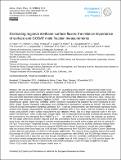Estimating regional methane surface fluxes: the relative importance of surface and GOSAT mole fraction measurements
Author(s)
Fraser, A.; Palmer, Paul I.; Feng, L.; Boesch, H.; Cogan, A.; Parker, R.; Dlugokencky, E.; Fraser, P. J.; Krummel, P. B.; Langenfelds, R. L.; O'Doherty, Simon; Steele, L. P.; van der Schoot, M.; Weiss, R. F.; Prinn, Ronald G.; ... Show more Show less
DownloadFraser-2013-Estimating regional.pdf (1.484Mb)
PUBLISHER_CC
Publisher with Creative Commons License
Creative Commons Attribution
Terms of use
Metadata
Show full item recordAbstract
We use an ensemble Kalman filter (EnKF), together with the GEOS-Chem chemistry transport model, to estimate regional monthly methane (CH[subscript 4]) fluxes for the period June 2009–December 2010 using proxy dry-air column-averaged mole fractions of methane (XCH[subscript 4]) from GOSAT (Greenhouse gases Observing SATellite) and/or NOAA ESRL (Earth System Research Laboratory) and CSIRO GASLAB (Global Atmospheric Sampling Laboratory) CH[subscript 4] surface mole fraction measurements. Global posterior estimates using GOSAT and/or surface measurements are between 510–516 Tg yr[superscript −1], which is less than, though within the uncertainty of, the prior global flux of 529 ± 25 Tg yr[superscript −1]. We find larger differences between regional prior and posterior fluxes, with the largest changes in monthly emissions (75 Tg yr[superscript −1]) occurring in Temperate Eurasia. In non-boreal regions the error reductions for inversions using the GOSAT data are at least three times larger (up to 45%) than if only surface data are assimilated, a reflection of the greater spatial coverage of GOSAT, with the two exceptions of latitudes >60° associated with a data filter and over Europe where the surface network adequately describes fluxes on our model spatial and temporal grid. We use CarbonTracker and GEOS-Chem XCO[subscript 2] model output to investigate model error on quantifying proxy GOSAT XCH[subscript 4] (involving model XCO[subscript 2]) and inferring methane flux estimates from surface mole fraction data and show similar resulting fluxes, with differences reflecting initial differences in the proxy value. Using a series of observing system simulation experiments (OSSEs) we characterize the posterior flux error introduced by non-uniform atmospheric sampling by GOSAT. We show that clear-sky measurements can theoretically reproduce fluxes within 10% of true values, with the exception of tropical regions where, due to a large seasonal cycle in the number of measurements because of clouds and aerosols, fluxes are within 15% of true fluxes. We evaluate our posterior methane fluxes by incorporating them into GEOS-Chem and sampling the model at the location and time of surface CH[subscript 4] measurements from the AGAGE (Advanced Global Atmospheric Gases Experiment) network and column XCH[subscript 4] measurements from TCCON (Total Carbon Column Observing Network). The posterior fluxes modestly improve the model agreement with AGAGE and TCCON data relative to prior fluxes, with the correlation coefficients (r[superscript 2]) increasing by a mean of 0.04 (range: −0.17 to 0.23) and the biases decreasing by a mean of 0.4 ppb (range: −8.9 to 8.4 ppb).
Date issued
2013-06Department
Massachusetts Institute of Technology. Center for Global Change ScienceJournal
Atmospheric Chemistry and Physics
Publisher
Copernicus GmbH
Citation
Fraser, A., P. I. Palmer, L. Feng, H. Boesch, A. Cogan, R. Parker, E. J. Dlugokencky, et al. “Estimating regional methane surface fluxes: the relative importance of surface and GOSAT mole fraction measurements.” Atmospheric Chemistry and Physics 13, no. 11 (June 13, 2013): 5697-5713.
Version: Final published version
ISSN
1680-7324
1680-7316